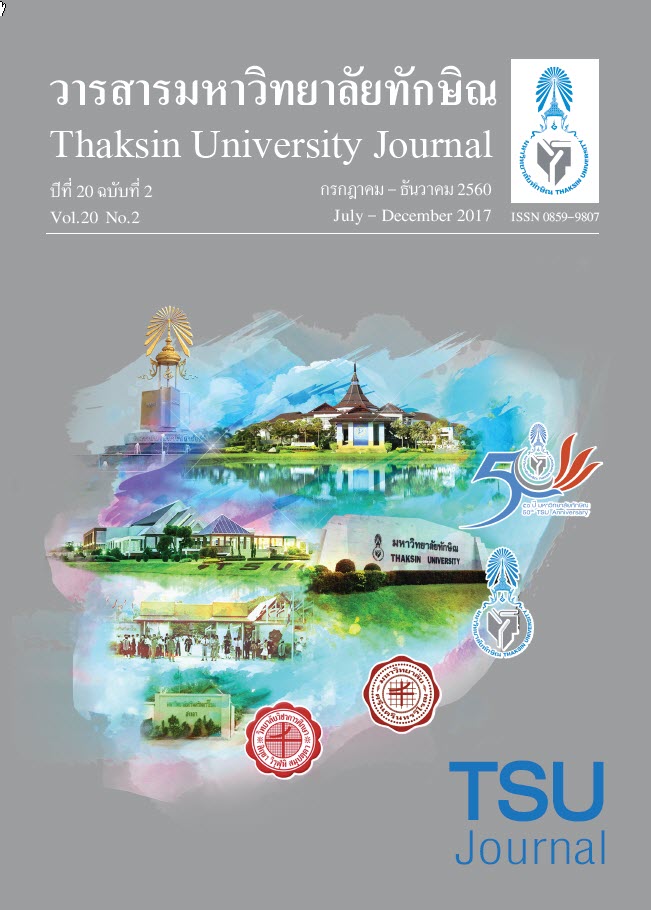A Study of Manufacturers and Steel Grades of Replacement Brush Cutter Blades in Surat Thani Province
Main Article Content
Abstract
The purposes of this research were to study details of labeling and packaging of 35 brands of the
replacement brush cutter blade purchased in Surat Thani province and to study the steel grades of the selected 7 brands. The samples could be classified by manufacturer into 3 product categories: Imported Blade (IB), Local Manufacturer Blade (LMB), and Unidentified Blade (UB). The numbers of IB, LMB, and UB were 4 (11.4%), 15 (42.9%) and 16 (45.7%) brands, respectively. Out of the 14 LMB brands, 2 brands had a completed details in Thai language details on labels, 2 brands were traceable by internet searching. Other brands were not traceable. In additions, the investigations of steel grades found that the blades were steel grades of 1050 1065 1070 and 1080, by referring to ASTM A682, which they were not tool steel grade as referred by ASTM A686 and JIS G4401.
Article Details
References
Behavior of Farmers in Surat Thani Province”, Journal of Agricultural ReRetrieved and Extension.
33(2), 74-81.
[2] Makita Corporation. (n.d.). Operating Manual RBC411 and RBC411U. Retrieved December 13, 2016,
from http://www.makita.com.vn.
[3] Kwon, Y.D., S.J. Park, W.G. Choi, S.I. Bang and H.W. Kwon. (2014). “Shear Cutting Theory for the Peripheral
Edges of Brush Blades, and Test of Its Effectiveness”, International Journal of Precision Engineering
and Manufacturing. 15(7), 1459-1465.
[4] Reekjirasawad, P. (2012). Fundamentals of Heat Treatment of Steels. Bangkok: Chulalongkorn University Press.
[5] Thailand Automotive Institute. (2010). A Study of the Potential of Automotive Spare Parts Manufacturers
(REM: Replacement Equipment Manufacturing) in the Country. Retrieved December 13, 2016,
from http://www.thaiauto.or.th.
[6] Office of the Council of State. (2016). Consumer Protection Act 1979. Retrieved December 13, 2016, from
http://www.krisdika.go.th.
[7] International Organization for Standardization (ISO). (2016). ISO 9001:2015 - Quality Management System
– Requirements. Geneva:International Organization for Standardization (ISO).
[8] Premanond, V. and Diewwanit, O. (2011). Metal Forming Work No.2 Mold and Workpiece Material.
Bangkok: Technology Promotion Association (Thai-Japanese).
[9] Satirajinda, M. (2000). Iron & Steel Heat Treatment Engineering (7th Edition). Bangkok: The Engineering
Institute of Thailand under His Majesty the King’s Patronage.
[10] ASTM International. (2002). ASTM A682–02 Standard Specification for Steel, Strip, High-Carbon,
Cold-Rolled, General Requirementsfor. Pennsylvania: ASTM International.
[11] Lau, K.H., D. Mei, C.F. Yueng and H.C. Man. (2000). “Wear characteristics and mechanisms of a thin edge
cutting blade”, Journal of Materials Processing Technology. 102(1-3), 203-207.
[12] Chucheep, T., Mahathaninwong, N., Janudom, S. and Wannasin, J. (2017). “Effect of Flame Hardening
Temperature on Hardness and Wear Properties of Band Saw Steel”, Thaksin University Journal.
20(1). 67-74.

